AGA 2008: Takashi Amano: His Tanks
November 18th, 2008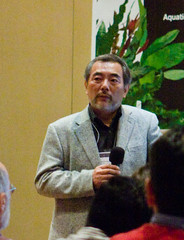 After critiquing the ADA entrant tanks during his presentation at the 2008 Aquatic Gardener’s Association Convention, Takashi Amano proceeded to discuss some tanks of his own. He spent a long time showing the exact progression several of his tanks have gone through from empty tank to finished aquascape. Afterward, he did show a number of pictures of his finished layouts.
After critiquing the ADA entrant tanks during his presentation at the 2008 Aquatic Gardener’s Association Convention, Takashi Amano proceeded to discuss some tanks of his own. He spent a long time showing the exact progression several of his tanks have gone through from empty tank to finished aquascape. Afterward, he did show a number of pictures of his finished layouts.
He started by showing a picture which was featured on the cover of Tropical Fish Hobbyist and given the title “Amano Magic!” He stated that it they called it magic because to the human eye it’s believable that this could be a natural habitat for those angelfish. He then said that this was incorrect.
He stated that it’s easy to fool a human eye, but the true test of an aquascape is whether or not the aquascaper has fooled the fish inhabitants that this is a natural environment. This could be discerned by looking at the coloration and interaction of the fish in the tank.
He showed a number of his tanks, such as my favorite one above, which are truly extraordinary, both in aquascape and photography. He flipped through a number of aquariums, demonstrating different types of aquascapes.
Some were more heavily planted, with moss covered wood as the focal point. He didn’t spend any time talking about the photography side of his aquarium pictures, but clearly he knows what he’s doing. I’ve read elsewhere that the ripple effect on the water’s surface was created using a hairdryer.
Amano also described how to create an iwagumi aquarium layout, such as in picture above. This is a more traditional iwagumi scape, utilizing only one or two types of plants, allowing the rocks to be the focal point.
He also showed that it was possible to create a nice iwagumi with more plants in more of a hybrid way, utililizing background and accent plants. Of course, the rocks are still the primary focus of the scape. Rock positioning and selection either make or break this type of scape.
This final aquascape was one of the ones that he showed from start to finish. As you can kind of see above, he started with a bare tank, and used poster board to keep the Aquasoil and Bright Sand separate. The two substrates were further separated by moss covered stones, and accented by driftwood. The tank is then planted, and allowed to grow in. After a rather harsh trimming, the plants grow back more bushy, and a few months later, you have your final aquascape below.
Mr. Amano ended his presentation talking about some non-aquarium-related work that he has been doing, nature photography. As you may know from his beautiful picture-books of the Amazon and Rio Negro, Amano is an expert photographer. He had two of his works displayed at the G8 Summit recently held in Japan with many world leaders.
The particular photograph displayed in the background above is of a huge tree in one of Japan’s ancient forests. He then answered a number of questions from convention attendees, and finished his presentation. Overall, it was a very insightful presentation, which some beautiful aquascapes on display.

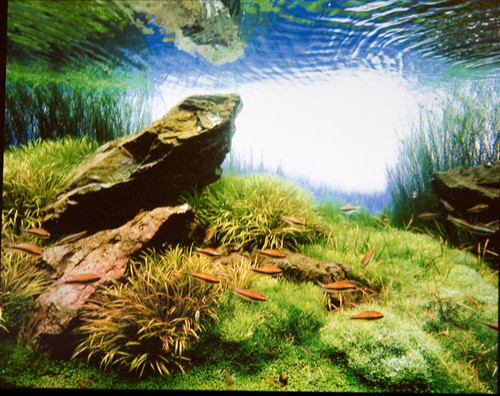
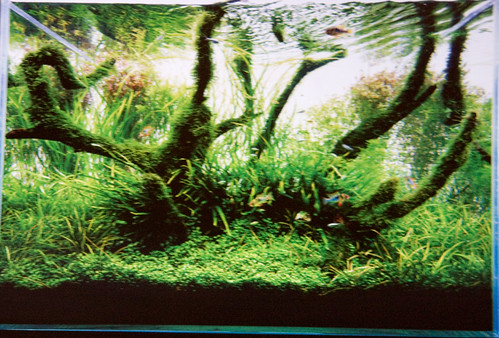

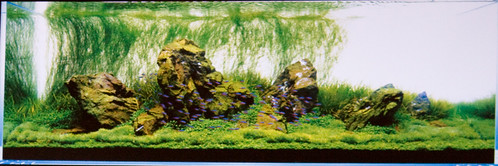
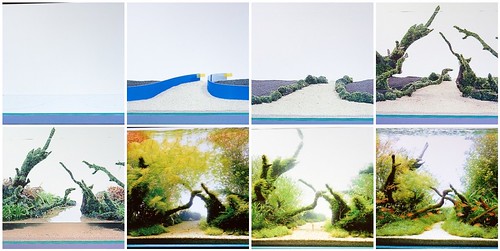
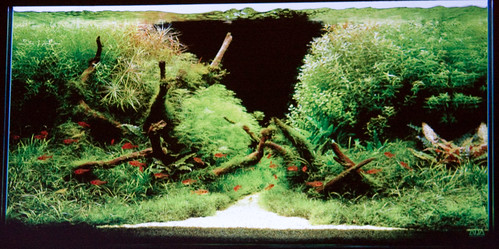

November 19th, 2008 at 7:08 pm
wow! Mr. Amano himself, truly unbelievable. I wonder how he is able to do so much.
November 19th, 2008 at 7:38 pm
Despite what I’ve said in my response to the previous posting, there’s no question that Amano’s a master at what he does. I was unaware that he also photographed real ecosystems/landscapes, etc. – are any of these of underwater scenes; of actual rivers, swamps, creeks, etc.?
There’s so many aquarists emulating terrestrial landscapes (mountains, glaciers, etc.) these days, yet – with the exception of saltwater reef tanks and a few African cichlid tanks – you very seldom see tanks that really look like the bottom of an actual aquatic ecosystem. Even planted tank biotope purists – the ones who only combine plant and fish species that would actually occur together in a pristine regional environment – often achieve a look of artifice, as if an interior decorator stepped into a creek and went to work. It would be nice to have more sources of underwater photography, from plant-rich freshwater environments, for aquascaping inspiration.
I was never a biotope purist (finances have always forced me to go low-tech), and have nothing against an element of fantasy in aquascaping (after all, ALL aquascaping is really fantasy, when you think about it) – but it would still be nice to have that source of inspiration. As it is, all I have to go on is a small handfull of photos from divergent sources, and my own experience taking a rare, occasional dip in North American and European rivers and reservoirs. (I’m a lousy swimmer!)
If you (or anybody else out there) can recommend a specific title by Amano – or any other photographer, for that matter – that would be great.
November 20th, 2008 at 10:55 am
That is a really cool that his photography was featured at the G8 summit. That tree photograph above is stunning.
November 20th, 2008 at 12:46 pm
Amazing! thanks for sharing. Good notes from the convention.
September 30th, 2010 at 1:11 am
Mr. Amano has also had the luxury of growing up in a land where the far reaching traditions of good taste have had influences even into daily life of the ordinary Japanese citizen. It might be interesting to know that the seven artistic principles of Zen Buddhism had an effect centuries ago on even the lowest ranking commoner. Luckily we can also share in that cultural feast for the eyes. We can take those principles and learn from them- and in so doing create our own unique style of aqua-art.
February 6th, 2012 at 3:41 am
Aaron Hernandez Jersey, Authentic Super Bowl XLVI Aaron Hernandez Jersey from Packers Store